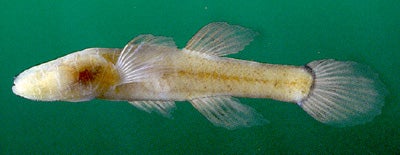SCIENTIFIC NAME:
Typhlichthys subterraneus
CHARACTERISTICS:
Compared to the Alabama cavefish, Speoplatyrhinus poulsoni, which has a small head and terminal mouth, the southern cavefish has a larger, broader head and a distinctly superior mouth. The fin rays are bifurcated, and the fin margins are smooth. Like S. poulsoni, the southern cavefish has an elaborate system of sensory papillae along the head and sides and also in two rows down the caudal fin. It has little or no pigment, although live specimens are light pink where blood vessels are near the skin surface. It lacks eyes but does have vestigial eye tissue below the skin. Anal and urogenital openings lie underneath the throat.
ADULT SIZE:
1.4 to 2.6 in (35 to 65 mm)
DISTRIBUTION:
The widely distributed southern cavefish occurs in the Ozark plateau of Missouri, Arkansas, and Oklahoma and in the Cumberland and interior low plateaus of north Alabama, northwest Georgia, and central Tennessee and Kentucky. In Alabama, Typhlichthys subterraneus, is found in limestone cave environments in the Tennessee River drainage and in subterranean waters of the Coosa River system.
HABITAT AND BIOLOGY:
Southern cavefishes occupy clear, mud-bottomed pools and flowing pools of limestone caves. Extensive field work in the Tennessee Valley indicates that distribution of these cavefishes may be partially limited by poor water quality and an inadequate food base. While the bulk of the southern cavefish’s diet is made up of copepods, it also includes other microcrustaceans, crayfish, and trichopteran and dipteran larvae. Poulson (1963) reports that this species begins to reproduce at 24 months. Spawning usually occurs in the spring when water levels rise, and some individuals attain an age of four or more years.
REMARKS:
This species is protected by rules and regulations of the Alabama Wildlife and Freshwater Fisheries Division.
ORIGINAL DESCRIPTION:
Girard described the southern cavefish in 1859.
ETYMOLOGY:
Typhlichthys means blind fish.
Subterraneus means beneath the earth, referring to the cave environments in which the species lives.
The copyrighted information above is from Fishes of Alabama and the Mobile Basin.
Southern cavefish may not be captured without a permit.






